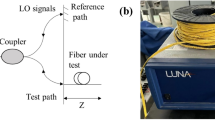Abstract
The traditional modal test of steel bars has two chief disadvantages of being time-consuming and having a complex detection operation. This paper presents the effective independence driving-point residue (EI-DPR) method for sensor optimal placement, which identifies cracks of steel bars based on the modal assurance criterion (MAC) and minimum mean square error (MMSE) criterion. The steel bars with cracks are tested separately by the uniform measuring point method and the optimal sensor placement method according to the vibration modal test. By comparing the test results, the optimal sensor placement method can identify cracks rapidly and accurately, which is more efficient than the uniform measuring point method. The study provides a reference for the rapid non-destructive testing of large-aspect ratio steel bars.








Similar content being viewed by others
References
S. Zhong, S.O. Oyadiji, Identification of cracks in beams with auxiliary mass spatial probing by stationary wavelet transform. J. Vib. Acoust. Trans. ASME 130(0410014), 041001-1–041001-14 (2008)
B. Li, D. Li, X. Zhao, J. Ou, Optimal sensor placement in health monitoring of suspension bridge. Sci. China Technol. Sci. 55(7), 2039–2047 (2012)
A.R.M. Rao, G. Anandakumar, Optimal placement of sensors for structural system identification and health monitoring using a hybrid swarm intelligence technique. Smart Mater. Struct. 16(6), 2658–2672 (2007)
T.-H. Yi, H.-N. Li, M. Gu, Optimal sensor placement for structural health monitoring based on multiple optimization strategies. Struct. Des. Tall Spec. Build. 20(7), 881–900 (2011)
S. Li, X. Cheng, Y. Chen, H. Zhang, The optimal placement of sensors in square target regions with varying boundary length. Procedia Eng 62, 899–906 (2012)
C.B. Larson, D.C. Zimmerman, E.L. Marek, A comparison of modal test planning techniques—excitation and sensor placement using the NASA 8-bay truss. Proc. Soc. Photo-Opt. Instrum. Eng. (SPIE) 2251, 205–211 (1994)
Y. Ling, X. Xu, L. Shen, J. Liu, Multi sensor data fusion method based on fuzzy neural network, in IEEE International Conference on Industrial Informatics INDIN (2008), pp. 153–158
R. Kumar, M. Wolenetz, B. Agarwalla, J.S. Shin, P. Hutto, A. Paul, U. Ramachandran, DFuse: a framework for distributed data fusion, in International Conference on Embedded Networked Sensor Systems (2003), pp 114–125
Z.N. Li, J. Tang, Q.S. Li, Optimal sensor locations for structural vibration measurements. Appl. Acoust. 65(8), 807–818 (2004)
H.B. Kim, Y.S. Park, Sensor placement guide for structural joint stiffness model improvement. Mech. Syst. Signal Process. 11(5), 651–672 (1997)
Q. Xie, S. Xue, A hybrid algorithm for optimal sensor placement of structural health monitoring. J. Tongji Univ. Nat. Sci. 34(6), 726–731 (2006)
D.S. Li, H.N. Li, C.P. Fritzen, The connection between effective independence and modal kinetic energy methods for sensor placement. J. Sound Vib. 305(4–5), 945–955 (2007)
D.C. Kammer, M.L. Tinker, Optimal placement of triaxial accelerometers for modal vibration tests. Mech. Syst. Signal Process. 18(1), 29–41 (2004)
D.C. Kammer, Optimal sensor placement for modal identification using system-realization methods. J. Guidance Control Dyn. 19(3), 729–731 (1996)
F.Z. Tajrishi, G. Roshan, A.R. Mirza, Optimal sensor placement for modal identification of a strap-braced cold formed steel frame based on improved genetic algorithm. Int. J. Optim. Civil Eng. 4(1), 93–119 (2014)
M. Pastor, M. Binda, T.H. Arik, Modal assurance criterion. Procedia Eng. 48(1), 543–548 (2012)
M. Guo, B. Li, J. Yang, S. Liang, Study of experimental modal analysis method of machine tool spindle system. J. Vibroeng. 17(6), 3173–3186 (2015)
M. Meo, G. Zumpano, On the optimal sensor placement techniques for a bridge structure. Eng. Struct. 27(10), 1488–1497 (2005)
Acknowledgments
This work was supported by the National Natural Science Foundation of China (Grant No. 51335003).
Author information
Authors and Affiliations
Corresponding author
Additional information
Publisher's Note
Springer Nature remains neutral with regard to jurisdictional claims in published maps and institutional affiliations.
Rights and permissions
About this article
Cite this article
Wang, L., Li, R., Liu, L. et al. Crack Identification of Steel Bar Based on Sensor Optimal Placement. J Fail. Anal. and Preven. 19, 866–873 (2019). https://doi.org/10.1007/s11668-019-00674-2
Received:
Published:
Issue Date:
DOI: https://doi.org/10.1007/s11668-019-00674-2




